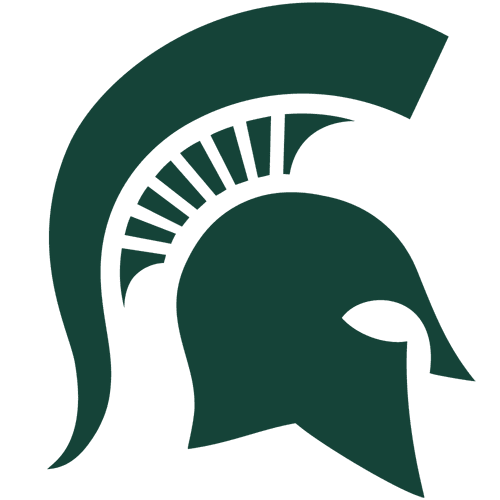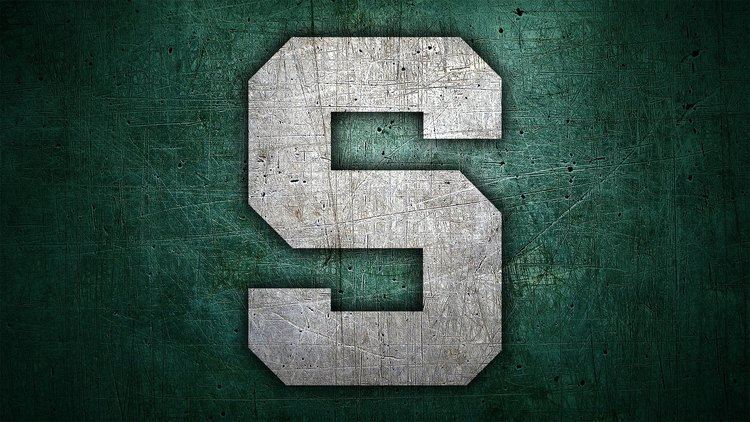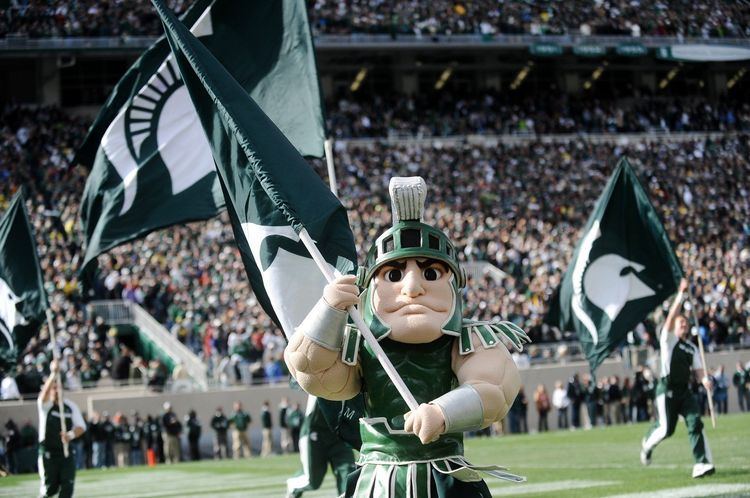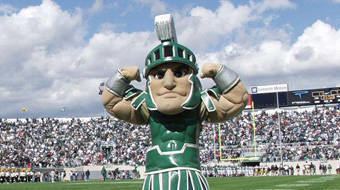First season 1896 Field surface Grass All-time record 684–450–44 (.599) | Seating capacity 75,005 Bowl record 11–15 (.423) Division Division I (NCAA) Athletic director Mark Hollis | |
 | ||
Rivals Michigan Wolverines football, Notre Dame Fighting Irish football, Indiana Hoosiers football, Wisconsin Badgers football | ||
Michigan state spartans football 2016 17 season hype unbelievable
The Michigan State Spartans football program represents Michigan State University in college football at the NCAA Division I Football Bowl Subdivision level. The Spartans are members of the Big Ten Conference. Michigan State claims a total of six national championships (1951, 1952, 1955, 1957, 1965, and 1966); the AP Poll voted Michigan State as national champion one time (1952). They have been named national champions twice in the Coaches Poll (1952 and 1965). The Spartans have also won two Michigan Intercollegiate Athletic Association championships (1903 and 1905) and nine Big Ten championships (1953, 1965, 1966, 1978, 1987, 1990, 2010, 2013, and 2015).
Contents
- Michigan state spartans football 2016 17 season hype unbelievable
- History
- Mark Dantonio
- Nick Saban
- George Perles
- Duffy Daugherty
- Biggie Munn
- Head coaching records
- Spartan Stadium
- Duffy Daugherty Building Skandalaris Center
- All time record
- National championships
- Conference championships
- Bowl games
- Rivalries
- Game of the Century
- Retired numbers
- Michigan States All Time Team
- College
- Professional United States
- Professional Canada
- Rose Bowl
- Current NFL players
- Big Ten East division opponents
- Non conference opponents
- References
The Spartans home games are played at Spartan Stadium, which is located on the main university campus. Spartan Stadium has ranked among the NCAA's Top 25 in attendance for 59 consecutive seasons, from 1953 through 2014. The Spartans' current coach, Mark Dantonio was hired on November 27, 2006. The team's iconic Spartan helmet logo has been ranked as one of the game's best.

History

Starting as a club sport in 1885, football gained varsity status in 1896. Early teams at the then Michigan Agricultural College (MAC) competed in the Michigan Intercollegiate Athletic Association (MIAA), which was chartered in 1888 and is the oldest existing collegiate leagues in the United States. Previously, in 1884, Albion College and Michigan Agricultural had played in the first intercollegiate football game held within the state of Michigan. The MIAA's other charter members included Albion, Olivet and Hillsdale Colleges. The Association's first season of competitive football was in 1894 which by then also included Eastern Michigan University (then Michigan Normal School) and Alma College; Kalamazoo College was added in 1896. In those early years the MAC Aggies could only accomplish one outright league football championship (1905) and share another with Albion (1903). The first decade of the 20th Century generally saw the MIAA and MAC being dominated by either Albion or Olivet Colleges. MSU left the league and became an Independent in 1907.

During the 1950s when Detroit was known as the world's leading automobile manufacturer, Michigan State was often referred to as the nation's "football factory." During this era, the Spartans produced great players such as Lynn Chandnois, Dorne Dibble, Don McAulliffe, Tom Yewcic, Sonny Grandelius, Bob Carey, Don Coleman, Earl Morrall and Dean Look. In 1951, the Spartans finished undefeated and untied to claim a share of the national championship with Tennessee. A second consecutive undefeated season led to a consensus national title in 1952. The team was admitted into the Big Ten as a regular member in 1953, winning the league championship and defeating UCLA in their first Rose Bowl game. After the 1953 season Biggie Munn, the Spartan coach, turned the team over to his protégé Duffy Daugherty.
Mark Dantonio
On November 27, 2006, Mark Dantonio was hired from the University of Cincinnati to become Michigan State's new men's football head coach. In 2010, Dantonio led MSU to earn a share of the Big Ten Championship after finishing the year in a three-way tie with Ohio State and Wisconsin, and an out right Big Ten Championship in 2013 & 2015. He has a 7-3 record against the University of Michigan (UM). Michigan State's streak of 4 wins in a row, from the 2008 season through 2011, tied Michigan State's best in the rivalry. Dantonio's record also includes a 4-4 mark for the Megaphone Trophy, which goes to the winner of the MSU vs. Notre Dame rivalry football game. Dantonio served as an assistant coach at MSU from 1995 to 2000 and was Ohio State's defensive coordinator during their 2002 national championship season. Dantonio was also an assistant at Kansas and Youngstown State University. He is considered a defensive-minded coach and has been on the coaching staffs of Glen Mason, Jim Tressel and Nick Saban. As of February 2017, his contract runs through 2023. Dantonio makes approximately $4.3 annually.
Nick Saban
When Saban arrived in East Lansing, Michigan prior to the 1995 season, MSU had not had a winning season since 1990, and the team was sanctioned by the NCAA for recruiting violations committed under his predecessor and former mentor, George Perles.
Saban never won a bowl game in his tenure at Michigan State, going 0-3 and losing those bowl contests by a combined 85 points.
George Perles
After returning from US Army active duty, Perles returned to Michigan where he enrolled at Michigan State University and played football under legendary coach Duffy Daugherty. Perles played the 1958 season before his playing career was cut short by a knee injury. Perles then started his football coaching career as a graduate assistant at Michigan State before moving on to the high school ranks in Chicago and Detroit, where his St. Ambrose High School team won their first Detroit City League Championship in 1961. Perles returned to Michigan State as defensive line coach under his mentor, Daugherty.
In 1972, Chuck Noll, head coach of the Pittsburgh Steelers, offered Perles the position of defensive line coach. In Perles’ first season, the Steelers made the NFL playoffs for the second time in franchise history, the first since 1947, losing to the Miami Dolphins in the AFC Championship Game. In 1974, the Steelers won the first of six consecutive AFC Central division championships and also their first Super Bowl. Perles became the defensive coordinator for the Steelers in 1978 and then assistant head coach under Noll in 1979. During Perles' ten years with Pittsburgh (1972–1981), the Steelers won a then-record four Super Bowls and became known as the team of the decade for the 1970s, largely on the back of their "Stunt 4-3" defense designed by Perles.
Perles returned to Michigan State University on December 3, 1982. In 12 years, he led the Spartans to two Big Ten Conference titles, seven bowl games and a victory in the 1988 Rose Bowl. The 1987 season marked the Spartans' last outright Big Ten title until 2013. During the 1987 season Perles and Michigan State beat Southern Cal twice in the same season, once in the regular season and one in the Rose Bowl.
During 1994–1995, an extensive external investigation conducted by the law firm of Bond, Schoeneck & King, PLLC. uncovered various infractions including grade tampering by an athletic department administrator. MSU president M. Peter McPherson fired Perles before the end of the 1994 season, and ordered the Spartans to forfeit their five wins for that season. Perles was found "not culpable" . Many fans and alumni believed he was treated unfairly. He later went on to be the founder of The Little Caesars Pizza Bowl and is on the MSU board of trustees.
Duffy Daugherty
Duffy Daugherty (September 8, 1915 – September 25, 1987) replaced Biggie Munn in December 1953, following Munn's retirement to become Michigan State's athletic director. Daugherty would serve as the head coach at Michigan State University from 1954 to 1972, where he compiled a career record of 109–69–5. Duffy's 1965 and 1966 teams won national championships. Duffy's tenure of 19 seasons at the helm of the Michigan State Spartans football team is the longest of any head coach in the program's history. He was inducted into the College Football Hall of Fame in 1984.
During Daugherty's time in East Lansing, he recruited and coached some of the best players in Michigan State's history, including Herb Adderley, Brad Van Pelt, Bubba Smith, George Webster, and Joe DeLamielleure. He was one of the first college football coaches to field a racially integrated team.
"Biggie" Munn
Clarence Lester "Biggie" Munn (September 11, 1908 – March 18, 1975) was head coach of Michigan State from (1947–1953). His 1951 squad and 1952 squad won national championships. Munn retired from coaching in 1953 to assume duties as Michigan State's athletic director, a position he held until 1971. Each year, the Michigan State Spartans football team hands out the "Biggie Munn Award" to the team's most motivational player. MSU's Munn Ice Arena, built in 1974, is named in his honor. Munn was inducted into the College Football Hall of Fame as a coach in 1959, and, in 1961, he became Michigan State's first inductee into the Michigan Sports Hall of Fame. He authored the coaching textbook Michigan State Multiple Offense in 1953.
Shortly after the Rose Bowl victory, MSU's athletic director, Ralph H. Young retired. Munn stepped down from coaching to assume duties as athletic director and remained in that position until 1971. Munn named his assistant, Duffy Daugherty, as his successor to helm the football team. During his tenure as Michigan State's head football coach, Munn tutored 17 All-Americans. His teams have retained the school's top four season marks for rushing-yards-per-game: 1948 (304.5 yards/game), 1951 (293.9 yards), 1952 (272.4), and 1950 (269.3). Munn was inducted into the College Football Hall of Fame in 1959.
Head coaching records
* The Big Ten split into the Leaders and Legends Divisions with the addition of Nebraska for the 2011 season. Michigan State played in the Legends Division from 2011 to 2013. In 2014, with the addition of Maryland and Rutgers, the divisions were realigned and Michigan State now plays in the East Division.
Spartan Stadium
Until the 1920s, the Spartans played on Old College Field just northwest of the current stadium. In the early 1920s school officials voted to construct a new stadium. The new College Field was ready in the fall of 1923 with a capacity of 14,000. In 1935 the seating capacity was increased to 26,000 and the facility was dedicated as Macklin Field. By 1957, upper decks were added to the east and west sides, boosting the capacity to 76,000. That same season Michigan State dropped the name Macklin Stadium in favor of the current name, Spartan Stadium.
In 2005 the university finished a new $64 million expansion project to Spartan Stadium. It featured the addition of nearly 3,000 club seats in the "Spartan Club," 24 suites and a 193-seat press box, bringing the current stadium capacity to 75,005. The original World War II-era terracotta cast of the "The Spartan" statue was moved indoors to the atrium of the new structure to protect it from the elements and occasional vandalism, and a new bronze cast was made for outdoors. The 200,000-square-foot (19,000 m2) addition also houses the MSU Alumni Association, University Development and other units.
The stadium boasts a capacity of 75,005, making it the Big Ten's 6th largest stadium and 23rd largest college football stadium in the country. In 2010 Spartan Stadium had the 19th highest attendance in NCAA Division I FBS. Crowd noise in the stadium gets so loud that Stanley Kubrick’s Spartacus (1960) uses a recording of the crowd noise during the 1959 Michigan State-Notre Dame game.
For the 2007 season, the student section held approximately 13,000 fans. Like the basketball student section (the Izzone), the Michigan State Student Alumni Foundation used to oversee a subgroup in the football student section named "Corner Blitz." When head coach Mark Dantonio took over the football program in 2006, "Corner Blitz" was united with the normal student section. The entire student section now receives a special T-shirt which is voted on annually.
Three new video boards were installed prior to the 2012 season. The larger South LED board measures 47.2 feet (14.4 m) high by 114.8 feet (35.0 m) wide for a total of 5,412 square feet (502.8 m2). The two North LED boards measure 31.5 feet (9.6 m) high by 52.5 feet (16.0 m) wide for a total of 1,653.75 square feet (153.638 m2) each. When combined, the three boards measure 8,719.5 square feet (810.07 m2), making it the largest combined board system in the country. Also, the stadium includes a 10 feet (3.0 m) high by 450 feet (140 m) wide ribbon video board along the top of the bleachers in the north endzone, which adds another 4,500 square feet (420 m2) to make a grand total of 13,219.5 square feet (1,228.13 m2).
Duffy Daugherty Building / Skandalaris Center
In 2007 Michigan State expanded its Duffy Daugherty Football Building with a $15 million expansion and renovation project. The face-lift started with construction of the 25,000-square-foot (2,300 m2) Skandalaris Football Center that features new team, staff and position meeting rooms, coaches' offices, MSU football Players Lounge and The Demmer Family Hall of History. MSU alumni Robert and Julie Skandalaris of Bloomfield Hills, Mich., donated $5 million as the lead gift for the $15 million project. In 2008, weight room was increased in size from 9,000 to 16,500 square feet (1,530 m2) at a cost of $2 million. The complex includes a 86,000-square-foot (8,000 m2) indoor practice facility with a full in-door football field, two outdoor practice football fields and a training room with a rehab and hydrotherapy section. Graphics in the space were provided by Ohio-based environmental designer, Ze Design.
All-time record
At the completion of the 2014 season, Michigan State's all-time record is 670–439–44.
National championships
Michigan State claims a total of six national championships, three of which are consensus national championships after being declared the national champion by the AP and Coaches' Poll in 1952, the Coaches' Poll in 1965, and the National Football Foundation in 1966.
Conference championships
* Denotes co-champions
Bowl games
The following are bowl game results for Michigan State football:
Rivalries
Game of the Century
The 1966 Michigan State vs. Notre Dame football game ("The Game of the Century") remains one of the greatest, and most controversial, games in college football history. The game was played in Michigan State's Spartan Stadium on November 19, 1966. Michigan State entered the contest 9–0 and ranked #2, while Notre Dame entered the contest 8–0 and ranked #1. Notre Dame elected not to try for the end zone on the final series, thus the game ended in a 10–10 tie with both schools recording national championships.
Irish quarterback Terry Hanratty was knocked out after getting sacked in the first quarter by Spartan defensive lineman Bubba Smith. Starting Notre Dame running back Nick Eddy was out entirely after hurting his shoulder getting off the train in East Lansing. Michigan State held a 10-0 lead by early in the second quarter. But the Irish came back, scoring a touchdown right after Michigan State's field goal and tied the game on the first play of the fourth quarter. Notre Dame had the ball on its own 30-yard line with 1:10 to go, needing about 40 yards for a game-winning field goal. But Notre Dame coach Ara Parseghian chose to run the clock out, not wanting to risk a turnover, preserving the tie and Notre Dame's #1 ranking. The game ended in a 10-10 tie.
Notre Dame beat Rose Bowl bound USC 51-0 in Los Angeles the next week, completing an undefeated regular season and moving them to #1 in both polls. The Irish did not accept bowl bids until 1969, and Michigan State was the victim of a pair of Big Ten rules that would be rescinded a few years later: The same school could not represent the league in the Rose Bowl in back-to-back seasons, and only the league Champions could accept a bowl bid, unless they refused the Rose Bowl bid or, because it was on probation, were prohibited from accepting the bid, which, in either case, would then go to the second-place team. So despite being Big Ten Champions and undefeated in the regular season, in each case for two seasons in a row, the Spartans could not play in the Rose Bowl.
For nearly 50 years, Parseghian has defended his end-of-the-game strategy, which left many fans feeling disappointed at the game not having some sort of resolution. College football expert Dan Jenkins lead off his article for Sports Illustrated by saying Parseghian chose to "Tie one for the Gipper." Others chided Notre Dame by calling them the "Tying Irish" instead of the "Fighting Irish."
Interestingly enough, the game was not shown live on national TV. Each team was allotted one national television appearance and two regional television appearances each season. Notre Dame had used their national TV slot in the season opening game against Purdue. ABC executives did not even want to show the game anywhere but the regional area, but pressure from the West Coast and the South (to the tune of 50,000 letters) made ABC air the game on tape delay.
The Sporting News named the 1966 Fighting Irish and 1965-66 Spartans the eleventh and thirteenth greatest teams of the 20th Century respectively.
Retired numbers
1 Although Hannah did not play for the Spartans, the University retired #46 as a recognition to his 46 years of service to the institution.
Michigan State's All-Time Team
Chosen in 2001 by Athlon Sports
College
Michigan State alumni and coaching inductees into the College Football Hall of Fame include:
Professional (United States)
Michigan State alumni inductees to the Pro Football Hall of Fame include:
Professional (Canada)
Michigan State alumni inductees to the Canadian Football Hall of Fame include:
Rose Bowl
Michigan State alumni inductees to the Rose Bowl Hall of Fame include:
Current NFL players
The following former players are in the NFL.
Big Ten East-division opponents
Michigan State plays the other six Big Ten East opponents once per season.
Non-conference opponents
Announced schedules as of January 15, 2015
